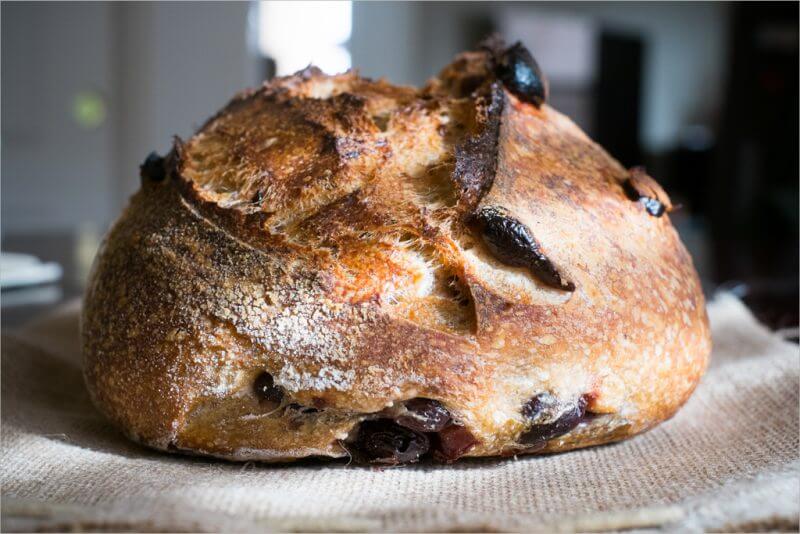Olives—there’s something about them, isn’t there? How can there be so many different types, and yet still, all of them taste so good? I have yet to find an olive I did not like. I got lucky this week and had many extra olives, we had planned to make another Moroccan dish (our current obsession) for dinner one night, but we never had the chance. No worries, I’m sure I could do something with all those incredible little things—enter this Tartine olive Sourdough.
Before I started baking sourdough at home olive bread was always one of my favorites. I knew baking my version would go well, but I didn’t realize it would go this well. The result is just so dang tasty having it sit out on the counter is just a bad idea. One more slice, sure why not.
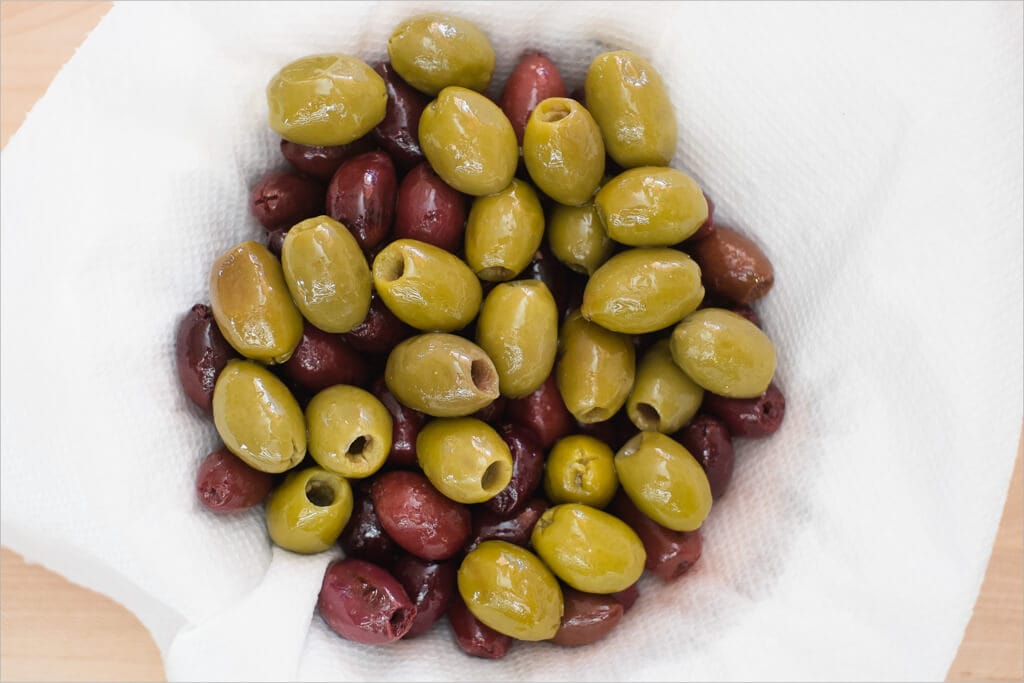
The olives I used for this were marinated in a salty, garlic sauce that isn’t what I had intended to use at the onset. The olives sure tasted good, but I think they contributed just a little bit too much flavor to the bread — just some straight pitted kalamata and Castelvetrano olives would be perfect. We recently signed up for a bi-weekly local produce box here in town, and I was pleased to find I could get organic olives in the shipment. I doubt they are local, but they don’t come drenched in any spices. This will be perfect for the next iteration of this bread.
Prepare the leaven – 10:30 p.m.
My typical 100% whole wheat leaven, prepared the night before:
- 31g ripe sourdough starter
- 110g whole wheat flour
- 110g water
After mixing the above in a glass container, cover and set out on the counter for an overnight rest. I started with water just a bit cooler than usual; I had some errands to take care of in the morning and needed a bit more time to mix after waking up.
I’ve realized that water temperature is one of the most useful tools in the baker’s arsenal.
Temperatures are so crucial with baking, and they usually are hard to control, the flour temperature is possible but not easy/practical, and the ambient temperature can be controlled to some level, but even a few degrees can drastically affect things. All that’s left is water temperature; this is easily modified in the microwave. Based on your schedule, mix with warmer water to speed things up, or colder water to slow things down.
Mix the flour, water, olives & spices and autolyse – 9:00 a.m.
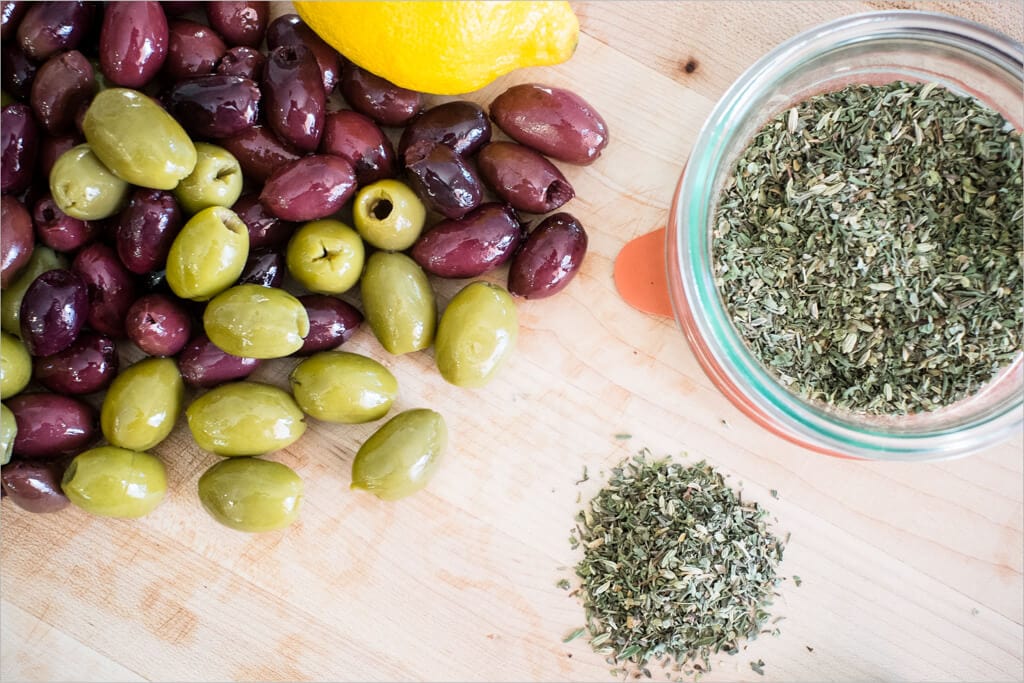
Ingredients:
- 250g (25%) leaven
- 800g (80%) white bread flour
- 200g (20%) whole wheat bread flour
- 20g (2%) salt
- 730g water and 50g in reserve for after you add the salt (step #5 in Method below)
- 3 cups pitted olives (I did 2 cups kalamata and 1 cup green), loosely chopped
- 2 tsp herbes de Provence
- Zest of one lemon
You might also notice here that I’m pushing 78% hydration with this loaf. I’ve slowly been increasing the water amount to try and achieve a softer and more tender crumb. I’ll be journaling my experience with these wet doughs in a future post. It can get challenging! You could reduce the water amount by up to 5% with no problem here.
Method:
- Add the 250g of leaven to a large mixing bowl
- Pour in the 730g water & mix with your hands until the water and leaven are thoroughly mixed and dissolved
- Add 800g white flour and 200g whole wheat flour and mix with your hand until all the dry flour is incorporated
- Cover your bowl with a towel and let it autolyse for 40 minutes
- After 40 minutes add 20g salt to the dough and slowly pour your 50g reserved water on top. Squeeze the dough with your hand to incorporate the salt
- Now reach your hand under the dough and pull one side up and over onto itself. Do this several times until you notice the consistency of the dough to turn sticky
- Transfer your dough to a large bowl for the bulk fermentation step. I usually use a clear-sided plastic container for my bulk fermentation, but the addition of the olives will be too much for the smaller container. Instead, I use my trusty large Heath Ceramic bowl (nice and thick for insulation).
After transferring to the large bowl, I read the final dough temperature: 75°F (24°C). Wow, it’s COLD out! This means the duration of bulk fermentation will need to be lengthened or I’m going to have to improvise and keep the dough at a warmer temperature. In hindsight, I should have used much warmer water, maybe even up to 90°F (30°C).
For more on dough temperatures and how it affects fermentation see my post on the Importance of Dough temperature.
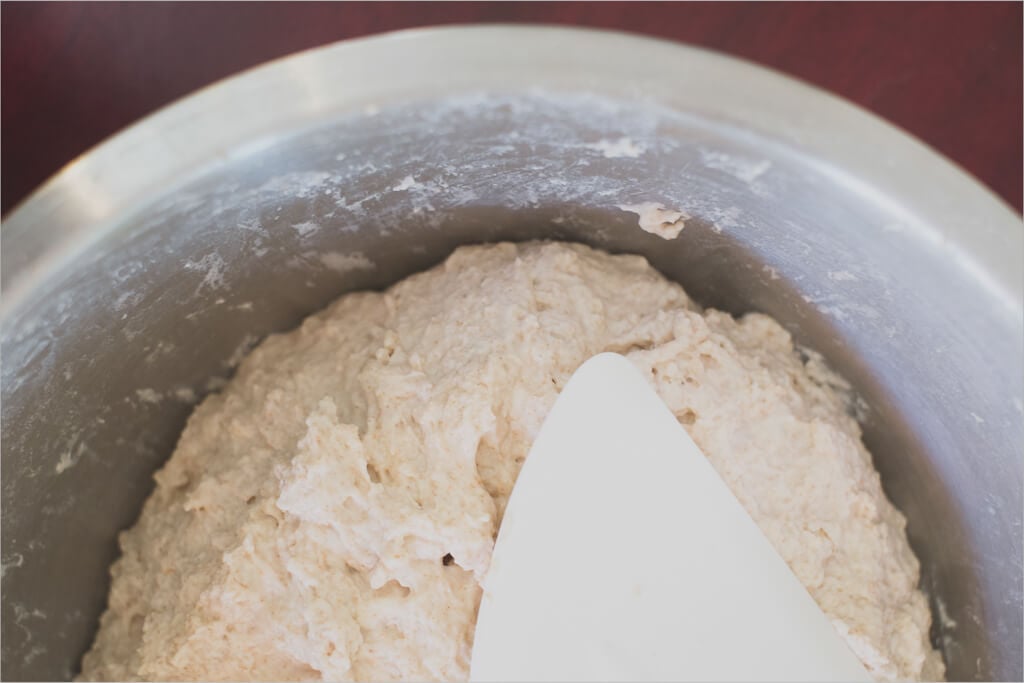
Bulk Fermentation – 9:45 a.m.
During bulk fermentation, you want to do 6 sets of stretch and folds spaced out 30 minutes apart. The stretch and folds should be quite intense to strengthen your dough over the next several hours. After the first set, add in the olives and herbs de Provence. If the mixture is overly dry after the addition, add a splash of water to help incorporate the ingredients. If you’re following my recipe exactly, you might not need any extra water (because of the already high 78% hydration).
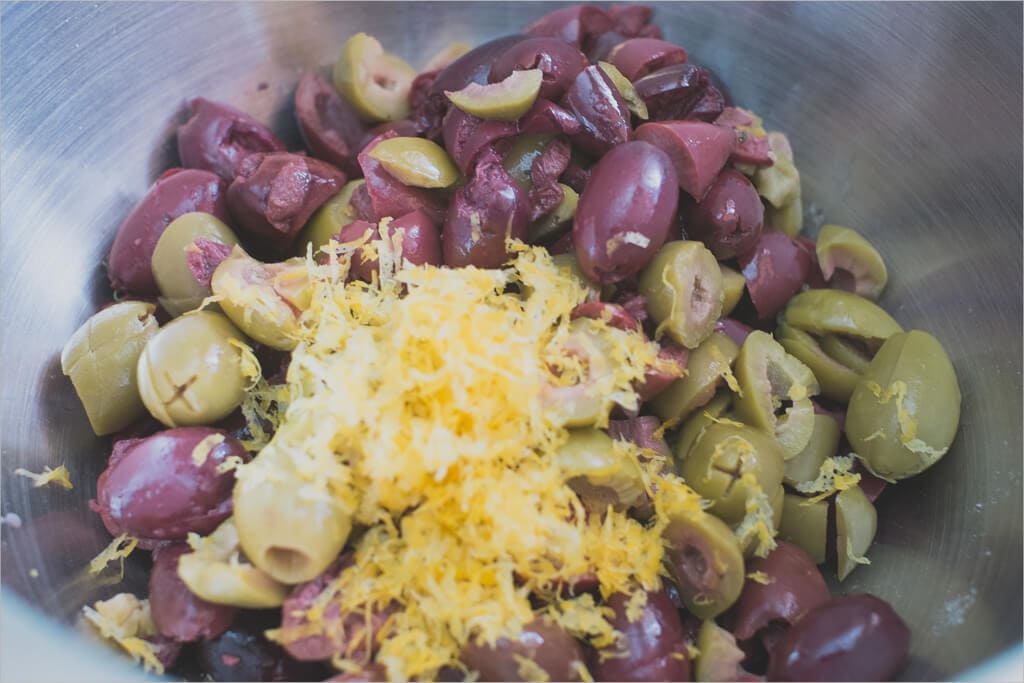
Mix the olives, herbs, and lemon zest in a medium bowl before incorporating into your dough. Set this mixture aside and we’ll add these to the dough after the first turn; get started:
- 10:30 a.m. – Turn 1
After the first turn, add in your 3 cups olives, 2 teaspoons herbs de Provence, and lemon zest. Mix thoroughly with your hand and cut the olives into the dough with your thumb and index finger.
- 11:00 a.m. – Turn 2
- 11:30 a.m. – Turn 3
- 12:00 p.m. – Turn 4
- 12:30 p.m. – Turn 5
- 1:00 p.m. – Turn 6
- 1:00 p.m. – 3:30 p.m. – Rest on counter untouched
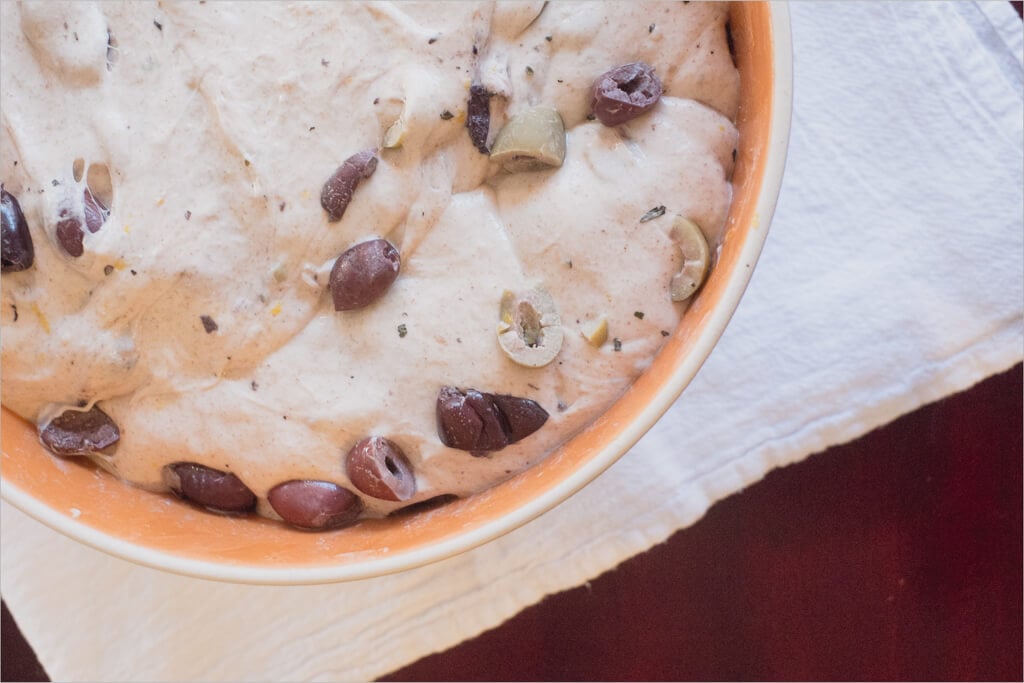
By 3:30 p.m. the dough had risen almost to the top of my bowl and was ready to be shaped. The olives dotted the dough and had me wanting to pick one or two out while shaping. It’s impossible to cook/bake good food without tasting the ingredients as you go along, right?
Pre-shape – 3:40 p.m.
Take the dough out of the container onto your unfloured work surface and sprinkle some flour on top before dividing. Divide the mass into two halves and flour the top of each half. After shaping, I inverted a bowl on top of each shaped mass to keep it from drying out and set a timer for 30 minutes.
I recently purchased another set of oblong proofing baskets so now I can do two batards instead of one batard and one boule. I much prefer the look of the batard, especially that single long score down the middle. Now that I have four baskets I can do a double batch of bread (that’s the plan for Christmas) and have all of them shaped in my favorite style.
Lightly dust your two linen-lined bowls with white rice flour. These bowls will hold our fermenting dough overnight in the fridge to proof.
Shape – 4:10 p.m.
Higher hydration doughs such as this can be very tricky to handle. I try not to incorporate any more flour than necessary, but there is a fine line here between too much flour and too sticky. Finding that balance only comes with experience.
I shaped each piece as an oblong, as seen here in my guide to shaping a batard.
Proof – 4:30 p.m.
After shaping, gently place the dough into their baskets and into the fridge for an overnight proof. My wife keeps telling me we need either a bigger fridge or a dedicated bread proofing fridge not enough space for food with double batches of dough! “It’s worth it” I keep telling her. She silently agrees each time she toasts a piece of bread in the morning with her eggs.
Score + Bake – 7:30 a.m. (the next day)
Gather your tools:
I baked these loaves using the combo cooker above, but a Dutch oven also works very well. See my guide to baking bread in a Dutch oven for tips and more guidance on the process!
Preheat your oven with an empty combo cooker (or Dutch oven) inside to 500°F (260°C) for one hour.
After one hour, take one of your loaves out of the fridge and cut a piece of parchment paper to place on top of the basket containing the dough. Take your peel and then put it on top of those two and quickly invert it, so the dough is now resting on the parchment paper and the peel.
Get your razor blade out and score the top of the loaf to allow the bread to expand while rising in the oven. I’ve been practicing more with my single long slash for the batard, and I think I’ve found my perfect angle. Take the razor and place it 90° over the loaf and then rotate left (I’m left-handed if you’re right-handed rotate right) by 45° and score.
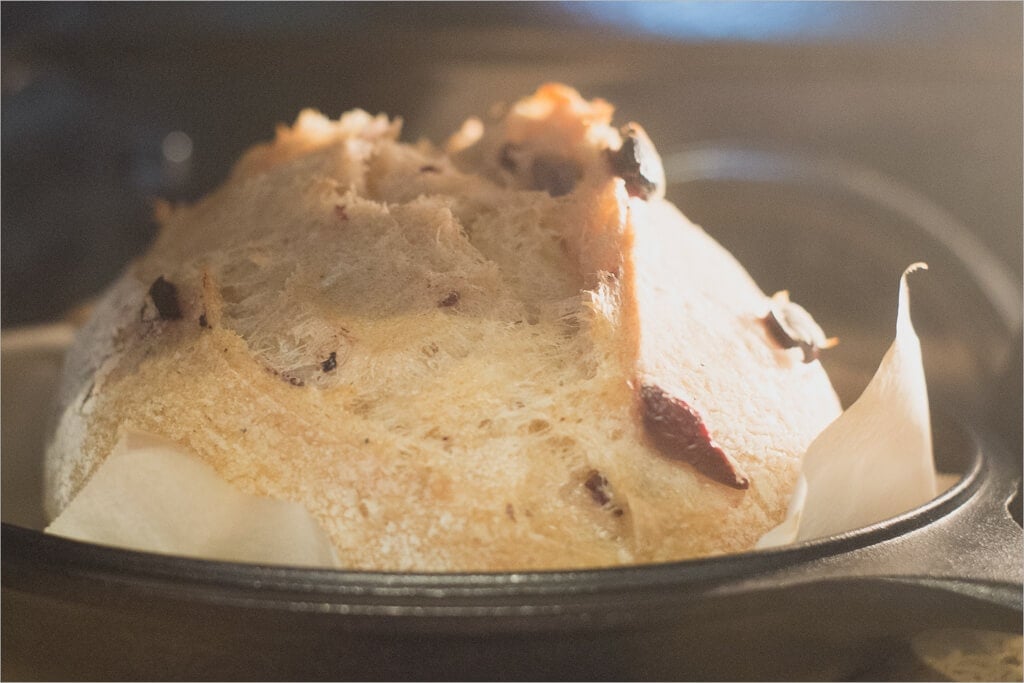
Place the dough into the combo cooker and turn the heat down to 450°F (230°C) and bake for 20 minutes. After this time, open the oven, remove the top lid of the combo cooker, close and bake for an additional 35 minutes or until done to your liking.
Repeat for the second loaf.
Conclusion
The salty taste of the olives really set this loaf off. I could hardly wait for the two loaves to cool before cutting into the first one. Keep that in mind when you bake these, start early, so you aren’t tempted at lunchtime to just cut right in and make a sandwich.
Crust
A beautiful crust; the color, the tears, the openness, all just really great. I love how the olives dot the surface of the bread, hinting at what’s inside. The crust turned out to be nice and thin and very brittle. After a few days, it hardened a bit more but that just added to the beautiful rustic nature of this bread.
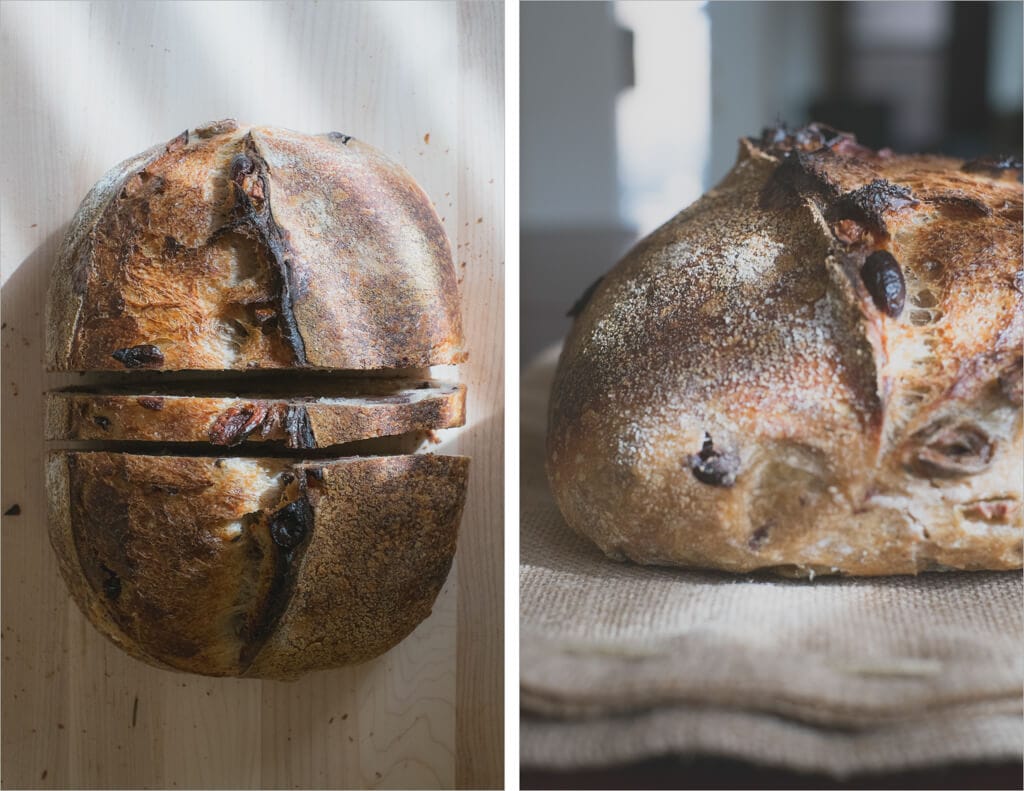
Crumb
Soft and open, a great combination. Next time I’m going to try to have a more decisive yet gentle hand when shaping. Perhaps I squished out too many of those precious air pockets developed during bulk fermentation. Still, the crumb was very nice.
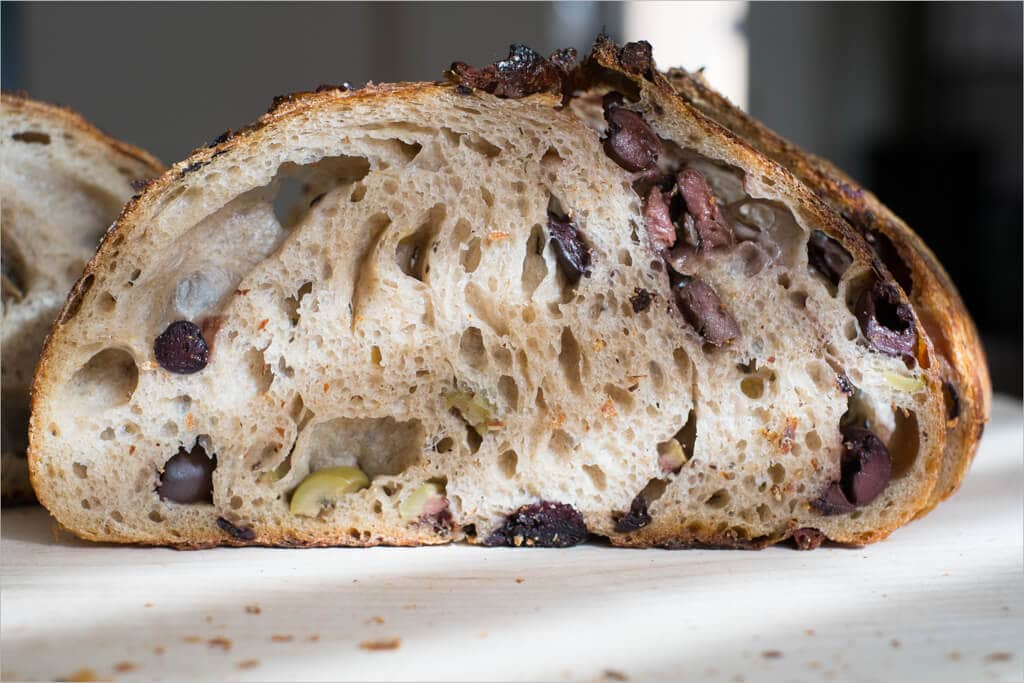
Taste
I’ve probably already beaten this to death at this point, but I’m serious: this bread is really something. Bake it and find out, you’ll be happy you did!
If you want to try another olive-based loaf, check out my green olive and herbes de Provence sourdough bread for another winner!
If you’re a big fan of Tartine like I am, check out this Bread Baker’s Date and Banana Tea Cake made with sourdough starter discard—it’s incredibly delicious.
Buon appetito!
If you use this recipe, tag @maurizio on Instagram so I can take a look!


